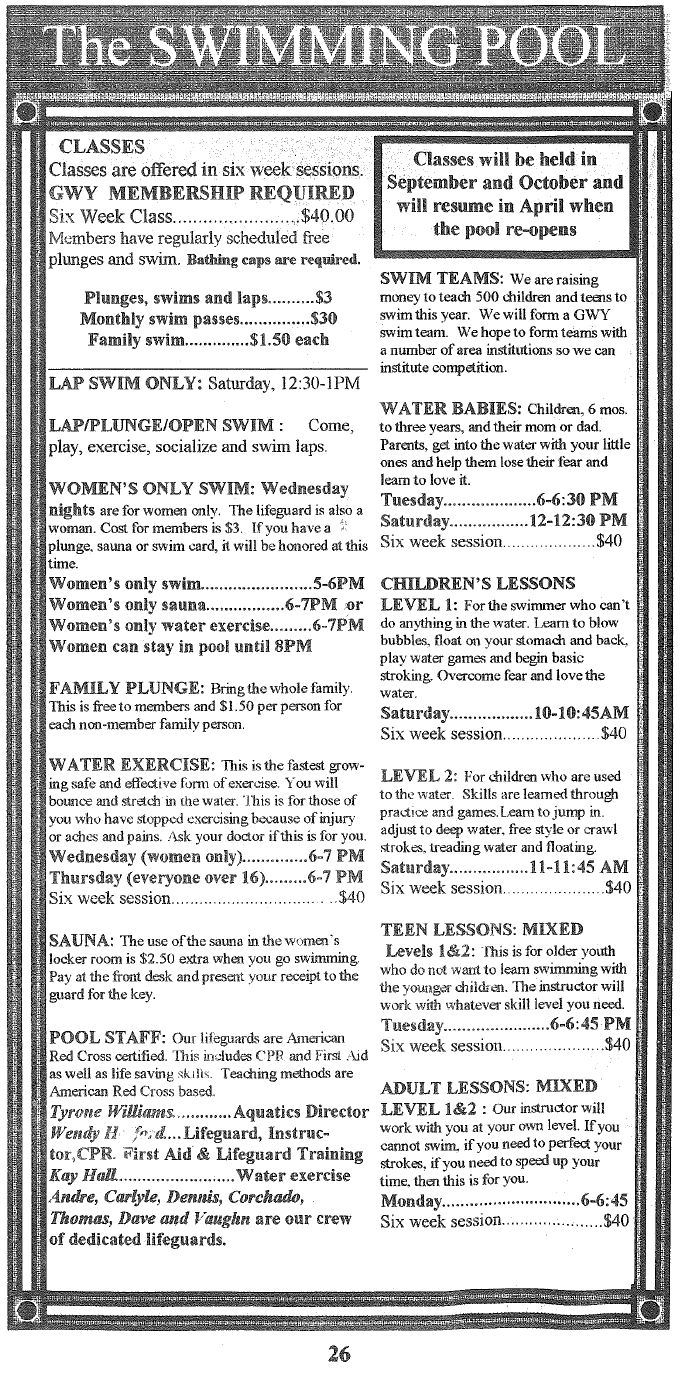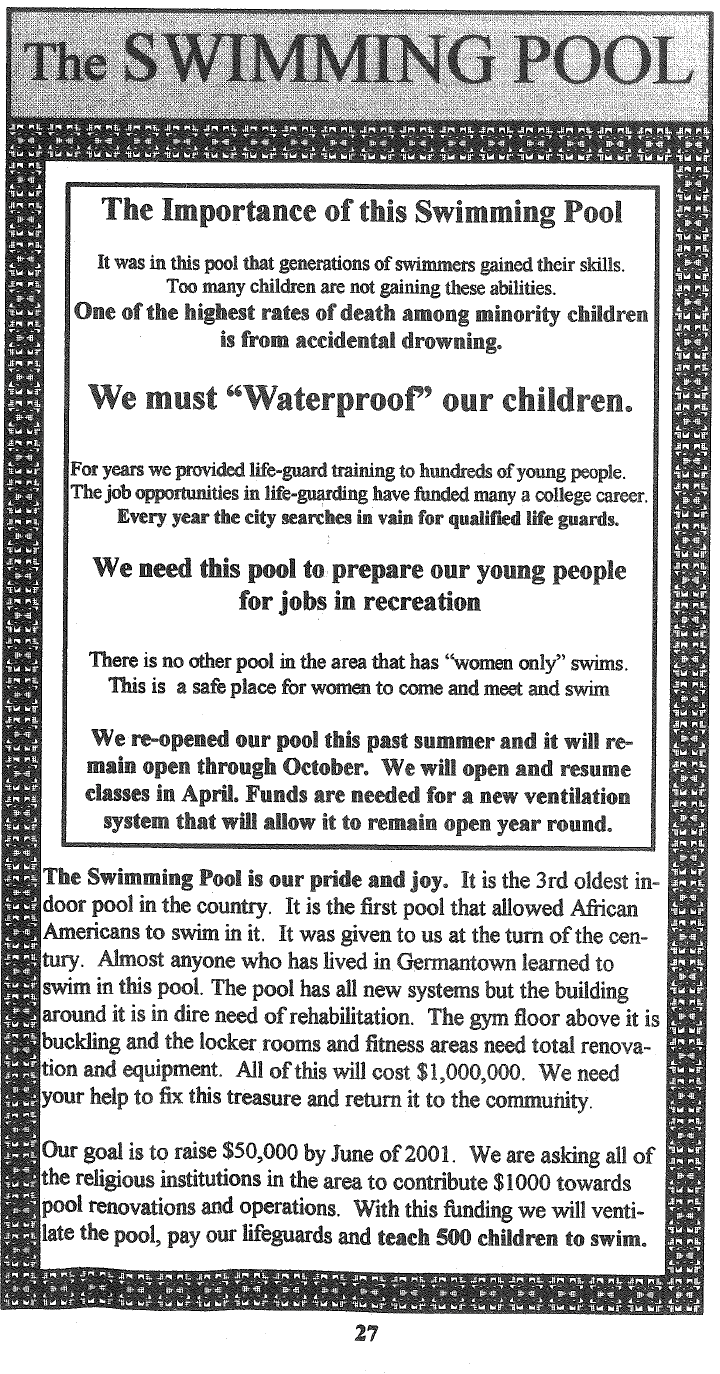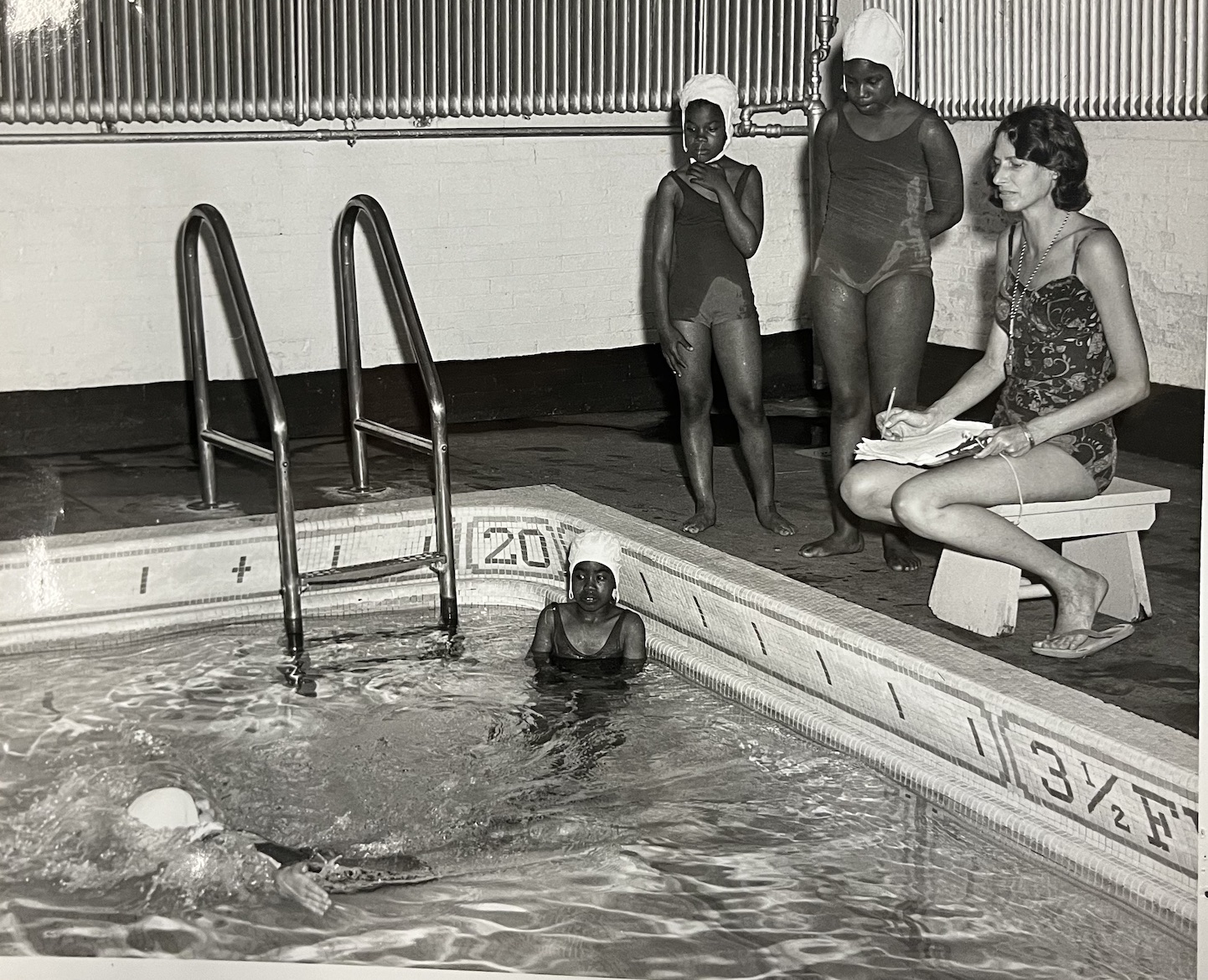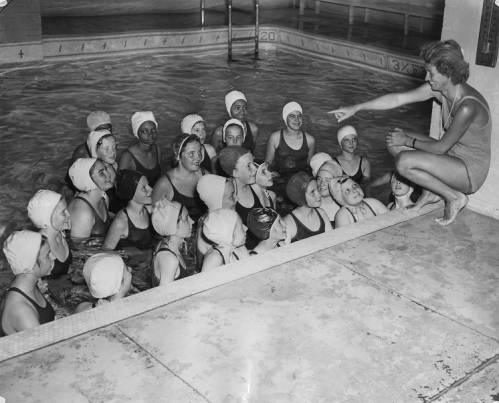The Swimming Pool
Grace Roebuck Bryn Mawr College Class of 2025 & Augusta Clusen Moses Bryn Mawr College Class of 2027
The swimming pool played a strong role in the community building that occurred at the Germantown YWCA. Due to its integration policies, extensive programming, and outreach efforts, and affordability, the pool served tens of thousands, most especially the women and children from Germantown and nearby areas. It also provided fundamental life skills such as swimming lessons, life saving lessons, and lifeguard certification classes. While the idea that access to a year-round, indoor swimming pool may seem commonplace now, in the early 20th century it was a highly rare, even revolutionary phenomena especially at the opening of the pool in 1917. Unfortunately, the Germantown YWCA remained segregated for its first 3 decades prior to its official integration in 1946. The Branch YWCA for Colored Women and Girls just up the street did not have a swimming pool, further complicating the Black community of Germantown from obtaining the valuable life skill of swimming. It has been over two decades since the Germantown YWCA closed, but still today many hold fond memories of the pool and all of the experiences it provided. To share its history and importance in the Philadelphia community we have collected archival images and oral history excerpts from past employees and members to honor its memory.
This is an excerpt from the pamphlet given out at the opening week of the YWCA’s new administration building (1915) that features goals set by the branch about how they want the pool to be used. It includes the mission to develop “strength” and “self-reliance and courage” in young women as well as instilling “good carriage and poise.” It also includes information about the shared swimsuits which were required and sanitized as well as rules for swimmers.
This 2000-2001 brochure is from the new group that took over the YWCA in 1999 when the former Board attempted to sell the building. The organization was renamed Germantown Women’s Y as it was disaffiliated by the national YWCA/USA the same year for owing $100,000 in dues. In this brochure from the YWCA, we see the dates, employees, times, and plans for the pool. Additionally, the pamphlet discusses the importance of children learning how to swim, especially for “minority” children, as drowning is cited as one of the highest causes of death at the time of this being published. As they say in the pamphlet “almost anyone who has lived in Germantown learned to swim in this pool,” showing that its need in the community is felt by many.
As seen in the image above, children in uniform swimsuits are taking part in swim lessons. This photo is from June 14th, 1966, and was utilized as publicity for the day camp that the YWCA housed. At this point in history, the YWCA had been an integrated space since 1946, a distinct and notable element of the organization, as they were on the forefront of the movement for integration. Women and children of all races shared the pool, and took part in programming that promoted women’s advancement of opportunity in society. The act of learning to swim is one of privilege as it can be hard to locate and pay for swim lessons. The YWCA serviced middle and working class Philadelphians, and it was only one of a few public, indoor swimming pools this demographic had access to.
This photo above is revolutionary for its time, as integrated swimming classes were almost unheard of until well after the 1960’s Civil Rights Movement and even then, were still resisted. This exemplifies the national YWCA’s long standing support for inclusivity and uplifting of minority communities, and further displays the importance that the space held. As seen in this photo, a majority of the students are teens, and after integration, the YWCA put a large emphasis on creating empowering programming for young women of all races. Not only were there significant efforts for women to learn and engage in swimming, but the YWCA also offered the opportunity to become a lifeguard or swimming instructor.
This photograph displays the various swimming programs that were available, including the option to enroll in life saving courses. It also includes the written detail that the pool provides sterilized swimwear.
This photo displays the pool after the YWCA was closed and sold to the local non-profit, Germantown Settlement, in 2006. Here, we see the pool drained and abandoned, and is filled with garbage. The windows in the background are boarded up, and the whole building generally appears dilapidated. Although there are copious amounts of repairs that would need to be done, the pool’s tiling and overall structure remains intact.
Oral History Quotes About the Pool, Conducted in the Fall of 2023 by Grace Roebuck:
An interview with Arleen Olshan, longtime Y member, part-time Art Director (1988-89) and Board Treasurer for a few years, talking about her experience using the pool as a safe space for lesbian and other women to meet and build community.
Arleen Olshen: One thing I should tell you, too, that the pool, the swimming pool, on Tuesday nights, back in the day, when we were part of Radicalesbians in the early 1970s, there was nude swimming there on Tuesday nights.
Grace Roebuck: Just for women?
Arleen Olshen: Just for women. And it was wonderful. I mean, we’d all be with our towels, and everything was really cool, and we’d all hang out. And it was both Lesbian and Straight women that went and maybe there would be like, 20 women there every Tuesday night, and it was fabulous! That Y was wonderful back in the day and it would be great to see it open again. It really would.
Grace Roebuck: That sounds amazing. Yeah.
Arleen Olshen: It’s very important to gain access to it [the building], and find out exactly what needs to be done. I mean, it’s not just like, unlock the doors and open the windows. I know that there’s all kinds of water damage and it probably needs a new roof. The pool was falling apart back in the day; the floors were buckling. There’s a lot of work to be done. If you can’t get access, you can’t know what the hell needs to be done.
An interview with Lyn Thompson Giles, longtime member and Assistant Director of YWCA in mid-to-late 1990’s during the Y’s decline and final years, expressing fond memories of the pool colored by the expense of maintaining it:
Lyn Thompson Giles: I remember getting a huge grant to refurbish some of the swimming pool because there was some fancy guy who had designed a swimming pool. It was $400,000, which should have been enough, but it wasn’t. I mean, it only took care of heating the pool. So the pool still needs to be cleaned. The pool still needs to be painted.
It was such a fabulous place to be from when I was a young girl to right before it closed. Because we used to have, in the summer, the kids would come to go swimming because there wasn’t a lot of outdoor pools, but you know, it was $1.50 to go swimming, and most people could afford $1.50 at that time. But then people would steal pipes. And it was just, it was just never enough money.
An interview with Ann Perrone, who spent much of her child and teen years at the YWCA as the daughter of the late Clarice Gamble Herbert (Teen Director 1954 – 1963, Executive Director 1968 – 1979.) Here, she shares her sensory memories of the YWCA and the pool:
Ann Perrone: I remember the smell of the swimming pool. You could smell the swimming pool as soon as you entered the front door. The swimming pool was down in the basement, it was under the gym, basically. And that sort of hot, humid chlorine smell. In my head, I see the pool. There’s not enough pools. Now, it’s not an Olympic sized pool. It’s not as big as the pool at the YMCA. It’s not like the Kroc Center, which has this gigantic pool, you know, it’s fine, whatever. But all those different rooms… I don’t believe in ghosts. But if there were ghosts, the ghosts of the people who created art, and who put on plays and had community dinners, and all the songs we used to sing and all the campers and all the tennis players and all the swimmers and all this synchronized swimming- which evidently is coming back, it’s like an Olympic…
Grace Roebuck: It’s an Olympic sport.
Ann Perrone: Right! I can remember synchronized swimming. I didn’t do it. But they had synchronized swimming, and you’d have a performance and people would come and sit at the side of the pool and watch the ladies go (mimes synchronized swimmers and sings) ‘Ah dah dah dah!’
Citations:
[Teen Swimming Lessons], [Box 44], Young Women’s Christian Association of Philadelphia (Pa.), Germantown Branch Records, Acc. 280, 877, PC-46, PC-89, Special Collections Research Center, Temple University Libraries, Philadelphia, Pennsylvania. [Day Camp Swimming Lessons], [Box 44], Young Women’s Christian Association of Philadelphia (Pa.), Germantown Branch Records, Acc. 280, 877, PC-46, PC-89, Special Collections Research Center, Temple University Libraries, Philadelphia, Pennsylvania. YWCA of Germantown, “The Swimming Pool” YWCA of Germantown, 2000-2001 Fall & Winter Schedule. Germantown Historical Society. 2000.






